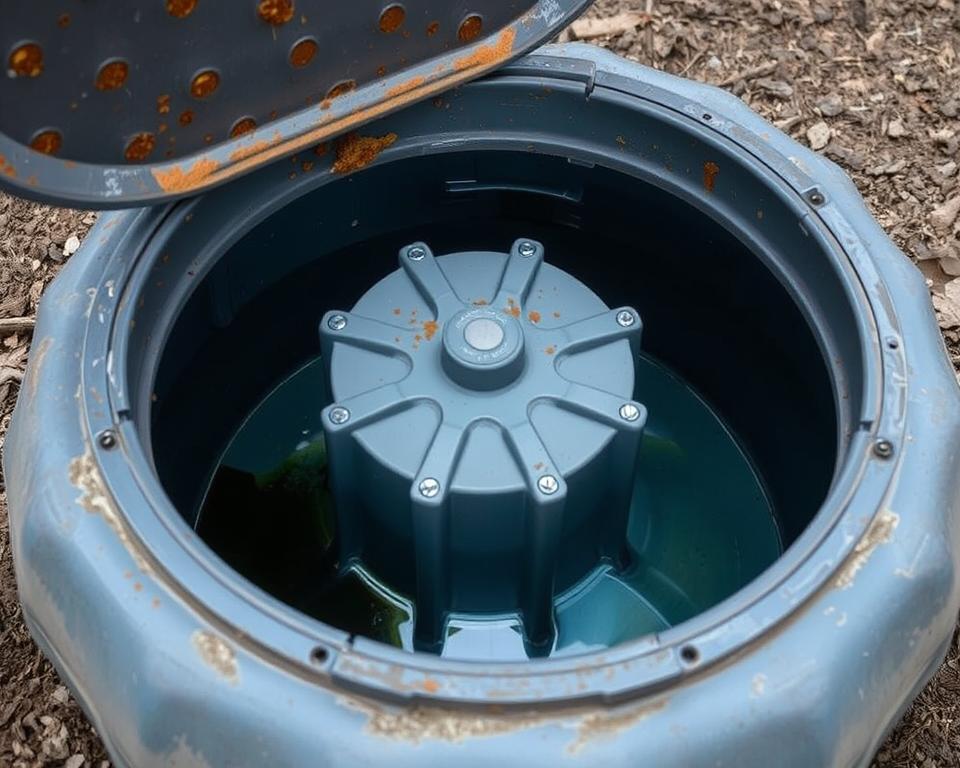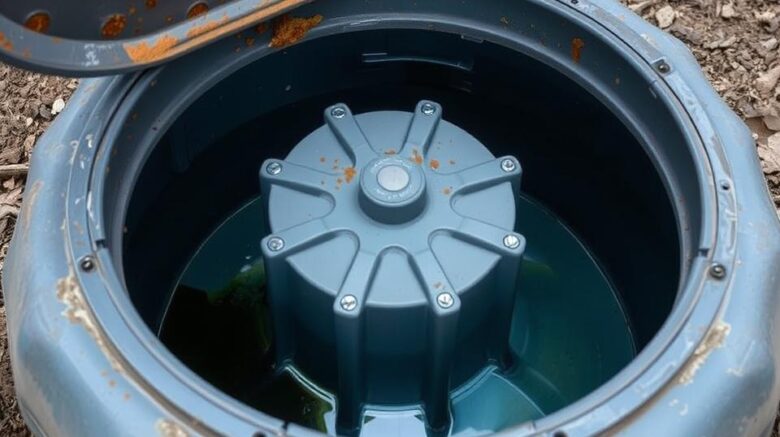Septic Tank Pumping Prices
Have you thought about the actual expense of maintaining your septic system current, or if you’re spending more than necessary? It’s essential for householders to grasp the specifics of septic tank pumping prices. Typically, the cost hovers around $420, though it can fluctuate significantly. This spread results from factors like your system’s size and your location – septic tank cleaning services near me.
Routine maintenance of your septic tank prevents expensive fixes, emphasizing the value of knowing service costs. Our goal is to examine septic tank service pricing in depth. This will enable smart budgeting financially for your system’s upkeep.
Core Findings
- Average septic tank pumping comes to about $420 USD.
- Prices can sit between $290 and $560 based on various variables.
- Regular servicing prevents pricier repairs later on.
- Most households require pumping every 3 to 5 years.
- Household size and use can impact pumping frequency.
Understanding the Importance of Septic Tank Pumping
Septic tank pumping is essential for a smooth‑running wastewater system. It extracts solids that, if not addressed, create blockages. Regular pumping not only avoids bad smells but also dodges high repair costs.
Neglecting septic tank maintenance can compromise our wide use on these systems. Thankfully, cost‑effective services lower the risk of system failure. Regular upkeep prolongs your septic system’s life, guaranteeing efficient operation.
Pricing for septic tank upkeep teaches the value of preventive care. Regular service detects problems early, heading off severe damage and hefty repair bills. Routine pumping is a prudent move for homeowners to secure their property and enjoy peace of mind.
Standard Fees for Septic Tank Pumping
Septic tank pumping typically comes between $250 USD and $600 in cost. In most cases, homeowners will spend about $400 for this critical service. Price variations are driven by factors like capacity, geographic setting, and how often maintenance is performed. Typical tanks, around a thousand gallons, usually cost between $225 and $400 USD.
Homeowners should recognize the necessity of allocating funds every three to five years for septic tank pumping. This scheduled care depends on the tank’s usage and size. It helps avert more serious, pricier issues later, showing to be both labor and money‑efficient.

Variables Affecting Septic Tank Pumping Prices
Multiple variables are key in establishing the fee of septic tank pumping. Understanding these details empowers homeowners to budget for these necessary services effectively.
The volume matters a lot. Bigger tanks require more labor and resources to empty, which means higher fees. The reachability to your tank also noticeably affects the price. Tanks buried deep or in challenging locations demand more time and special tools from technicians, thus boosting the labor costs.
Costs can differ widely depending on where you live. This is due to differences in local labor rates and waste‑processing costs. For example, some areas have higher charges for removing waste, impacting the final service cost. Moreover, tanks with significant solid waste accumulation also see additional fees—anywhere from $100 USD to $300. Plus, the more frequently a tank requires pumping—due to higher household wastewater production—the higher the ongoing expenses.
Septic Tank Capacity and Its Influence on Cost
The size of your septic tank strongly affects the cost of its upkeep. Compact tanks, for example, those that can hold 750 gallons, typically have lower pumping costs, commonly ranging from $175 to $300. On the other hand, bigger tanks, capable of holding up to 1,750 gallons, may incur charges between $400 and $700. The majority of single‑family residences use tanks that hold between 1,000 to twelve‑fifty gallons, providing a balance between capacity and function.
Households with smaller tanks or many residents often need more frequent pumping services, which raises the overall expense. It’s important to arrange regular septic tank inspections in these situations. This makes sure the tank does not overflow or malfunction, which sidesteps additional costs. By understanding the link between tank size and service fees, homeowners can reach well‑informed choices regarding their septic systems and their upkeep requirements.
Geographic Variations in Septic Tank Pumping Costs
Septic tank pumping costs can differ dramatically based on location. In urban areas, the expenses are typically higher due to local septic services experiencing increased overhead. For example, Minneapolis, MN residents may spend between $180 USD and $280 USD, while those in Portland, OR could see prices from $440 USD to $750.
The reasons behind these disparities are multifaceted. They include regional expenses, demand for septic specialists, and regional regulations. In places where septic services are in short supply, homeowners might incur higher charges due to the service scarcity. Moreover, tough regulations in some regions can push up the need for higher compliance fees, affecting the cost of services.
Knowing about these geographic cost variances is crucial for homeowners. It enables them to forecast their septic maintenance budget more accurately. By recognizing local pricing, they can get quotes from specialists wisely, servicing their septic system efficiently without financial strain.
Extra Expenses to Consider with Septic Tank Pumping
Homeowners often forget about various additional maintenance costs linked to septic tank pumping. The primary cost covers just the essential service, leaving out other potential expenses. Knowing these can assist with creating a complete budget.
Camera inspections, for instance, range between $250 to $500. They offer a minimally disruptive look into the system’s condition. Additionally, filter rinsing, which if overlooked can create system failures, represents another cost.
The window for repairs can be wide, from $100 to $4,000, according to the specific issues. This spread highlights the need of factoring in additional maintenance costs for future budgeting.
Budgeting for Septic Tank Maintenance
When planning for septic tank care, it’s critical to embrace a comprehensive view. This covers a few critical elements. Because of variable factors, the cost of maintenance can vary considerably. Therefore, smart financial planning is essential.
To make sure your system runs smoothly and to dodge unforeseen bills, keep these intervals and services in mind:
- Scheduled pumping: This service is typically required every 3 to 5 years.
- Inspections: Set aside for around $250 USD to $1,180 for inspections every three years.
- Potential repairs: Set aside a fund for unexpected fixes, which can occur unexpectedly.
Establishing a recurring maintenance calendar with a trusted septic service is crucial. By expecting these expenses, homeowners can sidestep the large costs tied to neglect. This approach ensures the longevity and efficiency of their septic systems.
Common Signs That Your Septic Tank Needs Pumping
Keeping watch to your septic system’s condition is vital. Spot the first indicators that suggest your septic tank is due for pumping. Doing so can prevent serious damage and reduce repair costs.
- Slow drains: Water with sluggish flow in sinks, tubs, or toilets could mean your septic tank is too full.
- Unpleasant odors: Bad smells around the septic tank or in your yard are frequently red flags of a problem.
- Gurgling sounds: Strange gurgling from your plumbing might indicate air is trapped because of a blockage.
- Wet spots: Puddles or greener grass sections near the drain field signal waste seepage from the tank.
- Dark green grass: Grass that is darker and appears robust around the drain field may point out leakage of nutrients, suggesting an issue.
Regular checks by septic system specialists can maintain your tank is in healthy condition. Using seasoned septic technicians for maintenance stops these issues, guaranteeing your system’s longevity.
Advantages of Regular Septic Tank Inspections
Regular inspections are key to maintaining your septic system in top condition. They identify potential problems before they turn into costly repairs. By engaging professionals for these checks, every part of your system gets a thorough assessment.
The process looks at various parts of your system, including waste levels and the drain field’s status. It ensures that critical parts, like baffles, operate as they should. Spotting issues early prevents harmful overflows and safeguards the environment, helping both your home and the wider community.
Scheduling your septic tank evaluated every three years can reduce a lot of money. It prevents bigger issues from occurring due to neglect. This not only cuts on repair costs but also secures your peace of mind.
| Inspection Aspect | Importance |
|---|---|
| Waste Level Assessment | Prevents overflow and backups |
| Drain Field Evaluation | Identifies saturation and function |
| Component Functionality Check | Ensures proper system operation |
| Early Problem Detection | Saves on repair costs |
Tactics to Save on Septic Tank Pumping Prices
Homeowners trying to lower septic tank pumping costs have multiple strategic options. Arranging group services with neighbors is one effective method. This involves teaming up with others nearby to book services collectively, potentially securing group discounts. It’s a way to strengthen community bonds while managing expenses more effectively.
Another practical approach is to sign up for maintenance plans with septic service providers. These plans often provide reduced rates for routine check‑ups and pumpings, keeping septic systems working properly at a lower cost. Homeowners are urged to ask about these plans when contacting service companies.
Making the septic tank easy to reach can also shave pumping expenses. Good accessibility means there’s no need for extra labor charges. It’s wise to keep the area around the tank free from obstructions, making way for straightforward servicing.
Embracing certain habits helps in extending the time between pumpings as well. Reducing water usage and minimizing garbage disposal use are critical practices. These actions can significantly enhance septic system health, reducing the need for regular maintenance. By implementing these habits, homeowners can efficiently trim their septic tank pumping costs, preserving their wallets and systems.
To Conclude
Ensuring regular septic tank pumping is crucial for homeowners who want to keep their waste management system healthy and in top shape. Understanding about the costs involved allows for effective budgeting. This way, you can get cost‑effective septic services without compromising your system’s smooth operation.
Taking a forward‑thinking approach to maintenance is highly rewarding. By looking out for signs that indicate the need for pumping, you can sidestep costly repairs and extend your system’s lifespan. Such actions not only boost your home’s functionality but also provide you peace of mind.
Ultimately, staying on top of routine inspections and timely septic tank pumping is critical for efficient home maintenance. By prioritizing proper planning and focusing on affordable septic service, you’ll ensure your septic system remains operational and effective for many years.
